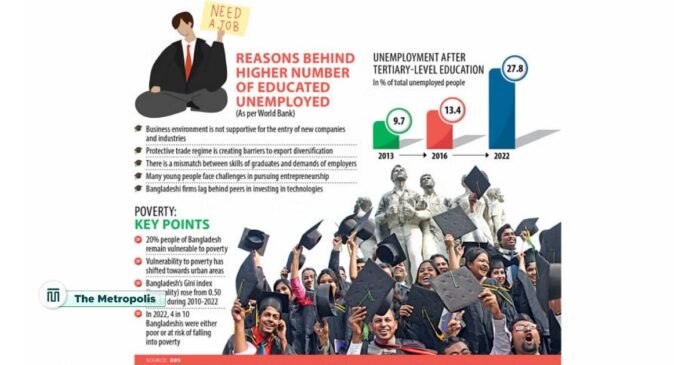The latest World Bank (WB) report states that the percentage of unemployed youth with tertiary education in Bangladesh’s overall unemployed population rose from 9.7 percent in 2013 to 27.8 percent in 2022 as many of them had difficulty finding jobs that matched their educational background and skill set.
Due to job losses and falling real wages, the report also stated that approximately 12 lakh people in the nation may experience extreme poverty this year.
In the “Bangladesh Development Update” report, the Washington-based multilateral lender stated that government jobs could employ just over 5% of the workforce.
Besides, it claimed that the private sector is not creating enough jobs.
Although many nations have policies that encourage entrepreneurship and startups, the World Bank reports that many young people in Bangladesh struggle to pursue entrepreneurship because they lack the necessary funds, resources, and mentors.
It claimed that one of the biggest obstacles to female entrepreneurs growing their companies and exporting goods is the lack of collateral and the discrimination against them by banks.
However, unemployment is still high because of the growing gap between graduates’ competencies and market demands, according to a number of studies.
“Younger and more educated cohorts, especially females, face high unemployment rates,” according to the report.
Although the nation’s unemployment rate decreased from 2016 to 2022, almost one-fifth of young women are still unemployed, suggesting that it is more difficult for women to find good jobs after graduating from college.
The report pointed out that discrimination in hiring practices, compensation, and upward mobility hinders female employment.
The World Bank country director for Bangladesh and Bhutan, Abdoulaye Seck, announced the report yesterday at the WB office in Dhaka. He said the analysis shows that young people, especially in urban areas, have a difficult time finding employment.
“Most new jobs have been created in the agriculture sector, where a significant portion are low-paying informal employment,” he explained.
In the industrial and service sectors, not enough jobs have been created. “The majority of businesses in Bangladesh are small and face a number of challenges in expanding and creating jobs,” he continued.
The manufacturing sector grew by 9.1% annually on average between 2016 and 2022, but employment in this sector fell by 9.6% during that same period. The WB reports that the majority of the new jobs were in the agricultural sector, with a large percentage of these jobs being low-paying informal work.
84.9 percent of all jobs are in the informal sector, which still dominates the economy, according to the multilateral lender.
Large-scale industry job creation has stalled. According to the report, only one out of every twelve formal private sector jobs is provided by frontier ready-made clothing companies, which account for almost half of all firm revenues in the nation.
According to the report, there are still many issues with the business environment, such as difficulty obtaining energy and financing, high operating costs, and onerous trade and customs laws, and foreign direct investment (FDI) is still low.
All things considered, real wages fell by an average of 2.6 percent in all categories, pointing to a sharp decline in living standards, especially for those with lower incomes.



